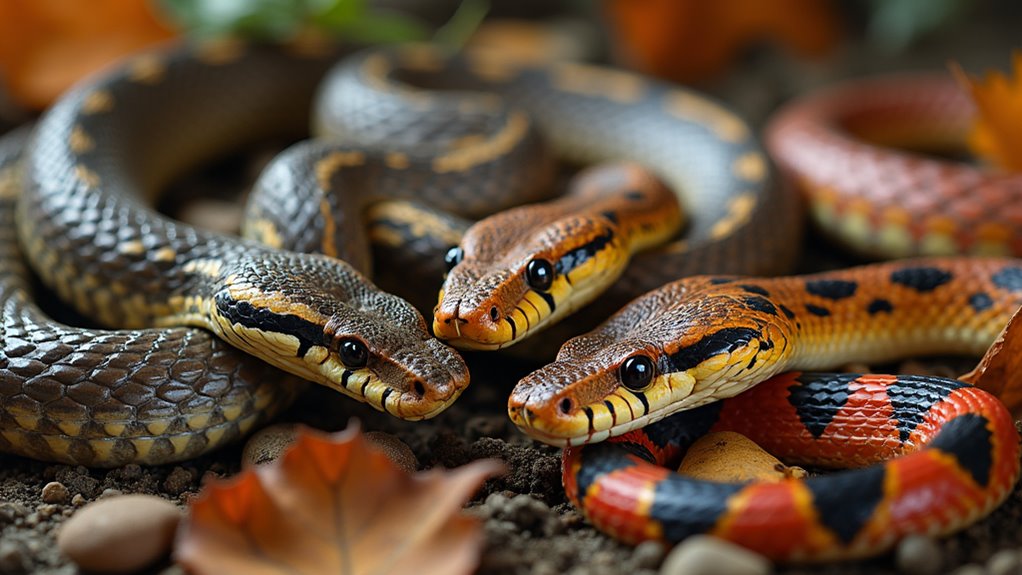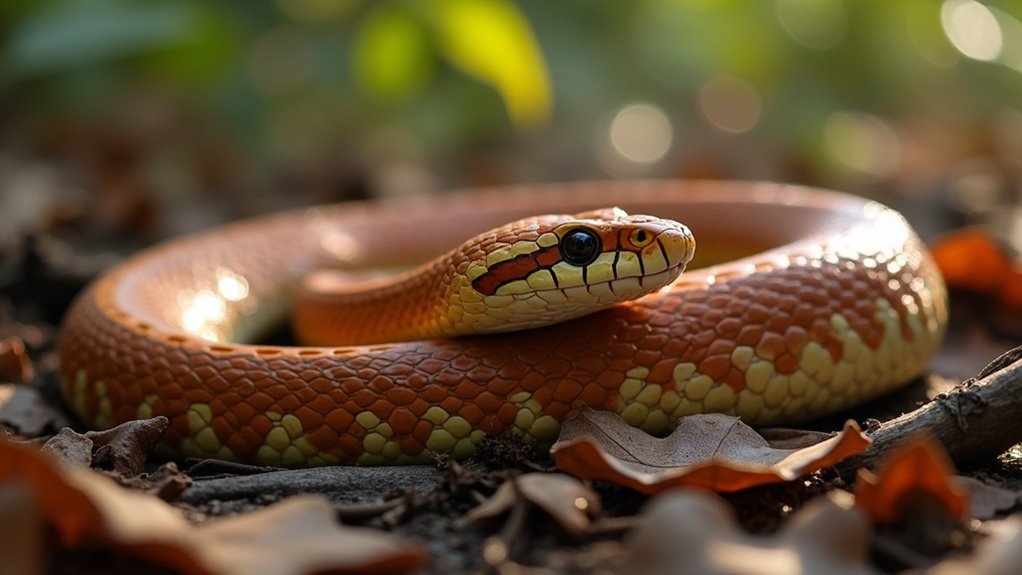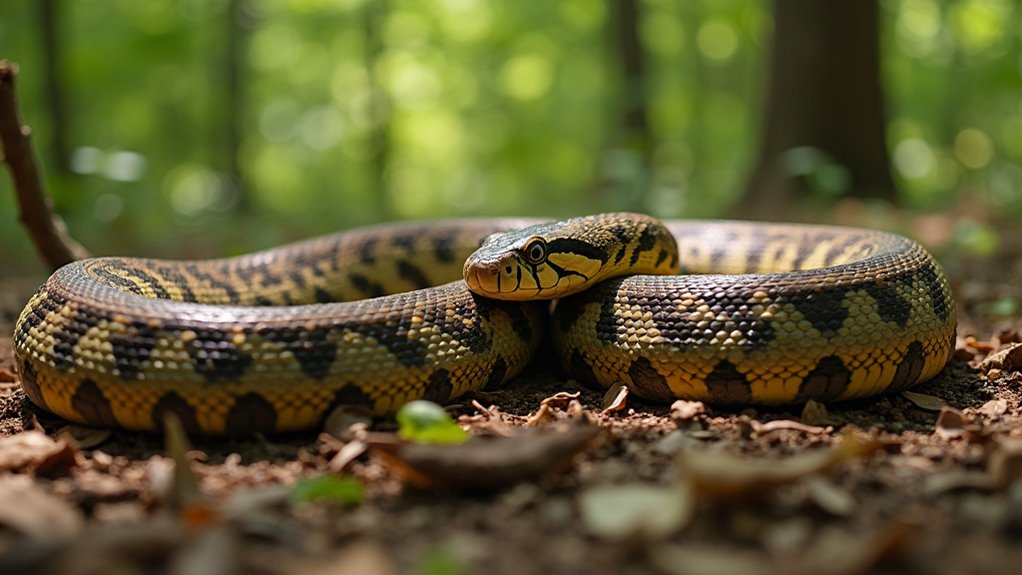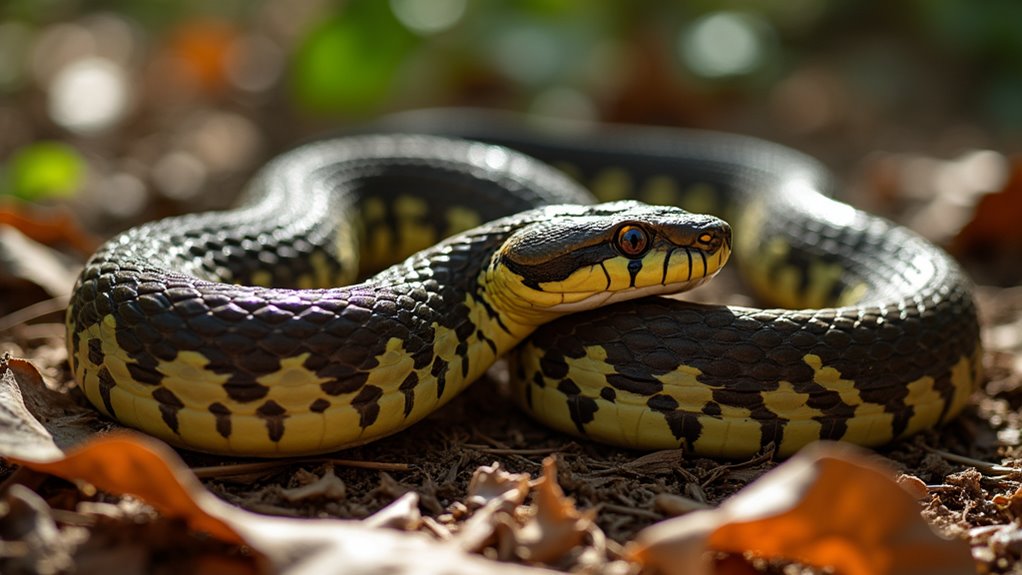Physical Address
304 North Cardinal St.
Dorchester Center, MA 02124
Physical Address
304 North Cardinal St.
Dorchester Center, MA 02124

Glimpse into Kentucky's dangerous serpents that lurk in forests and wetlands—could you identify all four before it's too late?
Kentucky hosts four venomous snake species, not five: Copperheads (found statewide), Water Moccasins (western wetlands), Timber Rattlesnakes (woodland areas), and Pigmy Rattlesnakes (western region). You’ll recognize them by triangular heads, elliptical pupils, and distinctive patterns. When outdoors, wear protective footwear, stick to trails, and use a flashlight after dark. Keep your distance if you encounter one. Proper identification and safety knowledge are your best protection in Kentucky’s wild areas.

While many Kentuckians fear encountering venomous snakes, the copperhead is prominent as the state’s most widespread venomous species, inhabiting every county across the Commonwealth. You’ll find them most frequently along Kentucky’s perimeter, with fewer populations in the bluegrass interior.
These pit vipers prefer rocky, wooded hillsides and areas near streams, often hiding in brush piles and woodpiles around human settlements. Most adult specimens measure around two feet long, though some exceptional individuals may reach up to four feet in length. You can identify copperheads by their coppery brown bodies with distinctive hourglass patterns and vertical, cat-like pupils in golden eyes.
Though responsible for most venomous bites in Kentucky, copperheads typically avoid human interaction. They’re most active during spring and fall, when you might spot them basking on rocky ledges before they retreat to limestone dens for winter hibernation.
Unlike the widespread copperhead, the water moccasin or cottonmouth inhabits only western Kentucky’s wetlands, primarily in the Jackson Purchase region and parts of the Western Coalfields.
The venomous cottonmouth’s Kentucky range is limited to western wetlands, unlike its cousin the copperhead found throughout the state.
You’ll find these snakes basking on logs near slow-moving water, where they hunt fish, amphibians, and small mammals.
When threatened, cottonmouths display their namesake white mouth lining and may vibrate their tail as a warning. These stocky snakes typically reach about 3 feet in length, though some Kentucky specimens grow to nearly 4 feet long.
Despite their intimidating reputation, they’re not typically aggressive unless provoked.
If you’re exploring western Kentucky’s wetlands, remember:

Among Kentucky’s venomous snakes, the timber rattlesnake stands as the most impressive in size and perhaps the most revered. You’ll find these woodland giants throughout the state’s deciduous forests and rocky outcrops, where they play vital roles in controlling rodent populations. These powerful pit vipers primarily hunt small to medium rodents including mice, squirrels, and chipmunks to maintain ecological balance.
Kentucky boasts a relatively healthy timber rattlesnake population despite the species’ decline elsewhere. These snakes typically inhabit elevations up to 2,100 feet, preferring rugged terrain for denning and basking. They’re skilled climbers, often surprising hikers by appearing in trees.
When exploring Kentucky’s wilderness, respect these long-lived reptiles—they can survive up to 20 years in the wild. Their distinctive diamond patterns and famous rattle serve as nature’s warning system, allowing you to appreciate these magnificent predators from a safe distance.
Don’t let the diminutive size of Kentucky’s pigmy rattlesnake fool you—this compact venomous serpent packs a powerful punch despite measuring only about two feet in length.
Found primarily in western Kentucky, these gray-brown snakes prefer wet habitats including swamps, floodplains, and forests.
Unlike their larger rattlesnake cousins, pigmy rattlesnakes have a small, barely audible rattle, making them harder to detect.
They’re generally reclusive but will defend themselves when threatened. When coiled, they typically appear roughly the size of a loblolly pine cone.
Though they’re reluctant biters, you should still exercise caution in their territory, especially during warm weather when they’re most active.

Kentucky’s four venomous snake species—Copperhead, Cottonmouth, Timber Rattlesnake, and Pigmy Rattlesnake—require residents and visitors to develop essential identification skills for safety.
Learn to recognize the coppery-red head and hourglass patterns of Copperheads, the white mouth lining of Cottonmouths, and the distinctive rattles of both rattlesnake species.
When outdoors, wear protective footwear and long pants, stick to established trails, and use flashlights after dark.
If you encounter a snake, remain calm and slowly back away. Don’t approach or attempt to handle it.
For bite prevention, avoid tall grass and dense vegetation, and always check before placing hands or feet in concealed areas. Look for snakes with triangular head shapes and elliptical pupils, which are key characteristics of Kentucky’s venomous species.
Kentucky’s five venomous snakes deserve your respect, not your fear. You’ve learned to identify the copperhead, cottonmouth, timber rattlesnake, and pigmy rattlesnake by their distinct markings and habitats. Isn’t it empowering to know you can safely explore the Bluegrass State’s wilderness with this knowledge? Remember to keep your distance, watch your step, and appreciate these important predators from afar. Your outdoor adventures just got safer.